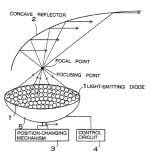Permlight issued LED luminaire patent
Permlight Products has been awarded US patent number 7,102,172 entitled “LED Luminaire”. The patent claims cover Permlight’s modular LED technology of integrated thermally managed LEDs, electronic ballasts, and luminaire housing coupled to heat dissipating junction boxes and recessed cans.
“This new patent award continues to show Permlight’s leadership as the thermally managed LED lighting company,” commented Manuel Lynch, President and CEO of Permlight. “Our residential LED luminaires use a patented design that ensures the consumer a low cost and long lifetime solution.”
Nichia, Daisho Denki patent LED lighting fixtureThe patent describes a lighting apparatus with an array of red, green and blue LEDs that emit light toward a focusing point. A control circuit controls the light intensity of each LED. A concave reflector is provided for reflecting and radiating the light focused from the LEDs to the focusing point so that the light is further focused or scattered. The apparatus also has a position-changing mechanism for changing a relative position of the concave reflector relative to the focusing point of the LEDs.
CAO Group patents LED curing lightThe new patent applies to a hand-held wand for manipulating a curing light, with controls on the wand for controlling transmission of light from the curing light. The wand contains two heat sinks, and a light emitting semiconductor device. Light emitted directly forward from the light emitting semiconductor device travels at an angular orientation in the range of 30 to 150 degrees, and exits the curing light without passing through a light guide.
Patent awarded for system to replace RFID tags
US patent 7,061,395 entitled "Locating items with flickering lamps" relates to a system of tags and detectors which has broad application in the areas of homeland security, supply chain management, retail sales, and access control.
The tags will perform the same general function as RFID tags, which are widely used to track shipments, deter theft, unlock doors, and control inventory. Unlike RFID tags, which emit radio waves, the patented LED tags will emit visible light, infrared, or ultraviolet. They will have advantages over RFID tags in distance reading and simultaneous reading.
One flicker from a tag, lasting about a thousandth of a second, will convey any desired information about the identity and status of a tagged item. The flickers will continually recur, at intervals of about a second. Because the flickers from a collection of items are not coordinated, a collection of tagged items will flicker like fireflies at night, the flickers from the various items will not overlap, and a detector will be able to detect the identities of hundreds of items in about a second. An optical flicker can be read at any distance.
RFID tags have recently been shown to have security problems, with experts warning that they can transmit computer viruses, and can be altered or disabled by a cell phone. LED tags could be more secure, because they do not emit or respond to radio waves. LED tags could be made completely compatible with any bar code system because those systems read flickering light.
LED pixel modules
Barco has been awarded US patent 7,102,601 entitled "Pixel Module for Use in a Large-Area Display."
The patent describes a LED-based pixel module for use in a large-area display. The display comprises a cluster of sequentially-interconnected pixel modules that are driven by a central controller. The module includes pixel elements that have a serial video data bus input, and command input lines that are electrically connected to inputs of a latch. The latch has parallel inputs and outputs which are clocked with a data dock input. Also included are a current driver device for driving the pixels, a first inverter for driving the data clock input, an address input connected to a second inverter, an EEPROM connected to the input port, and a power supply.
LED strobe light
Dialight has been awarded US patent 7,095,187 entitled "LED Strobe Light."
The patent describes an LED strobe light that could be used in photography or in entertainment venues, for example, or as an obstruction light on emergency vehicles or radio towers. The light comprises an LED light source mounted onto a thermoelectric device, which maintains the LEDs within a predetermined temperature range. A controller provides a pulse signal to the LED light source, so that the LED light can operate as a strobe.
Control circuit for dimming and color mixing
Boca Flasher has been awarded US patent 7,088,059 entitled "Modulated Control Circuit and Method for Current-Limited Dimming and Color Mixing of Display and Illumination Systems."
The patent describes a control circuit for a lighting system that allows analog control over a range of illumination intensities in which the source intensity varies in proportion to the voltage level of the control signal. The circuit provides for improved dimming and color mixing capability by allowing pulse width or frequency modulation control in addition to analog control over a second range of illumination intensities.
Light mixing system
Illumination Management Solutions has been awarded US patent 7,083,304 entitled "Apparatus and Method of Using Light Sources of Differing Wavelengths in an Unitized Beam."
The patent describes an array of LEDs with different wavelengths, each with a corresponding reflector, to form a series of LED-reflector pairs. The reflected light is mixed to generate a composite light from the LED array. The reflectors are coated with a dichroic filter material to reflect the specific color of light radiated by the paired LED, and to transmit light emitted by other LEDs.







